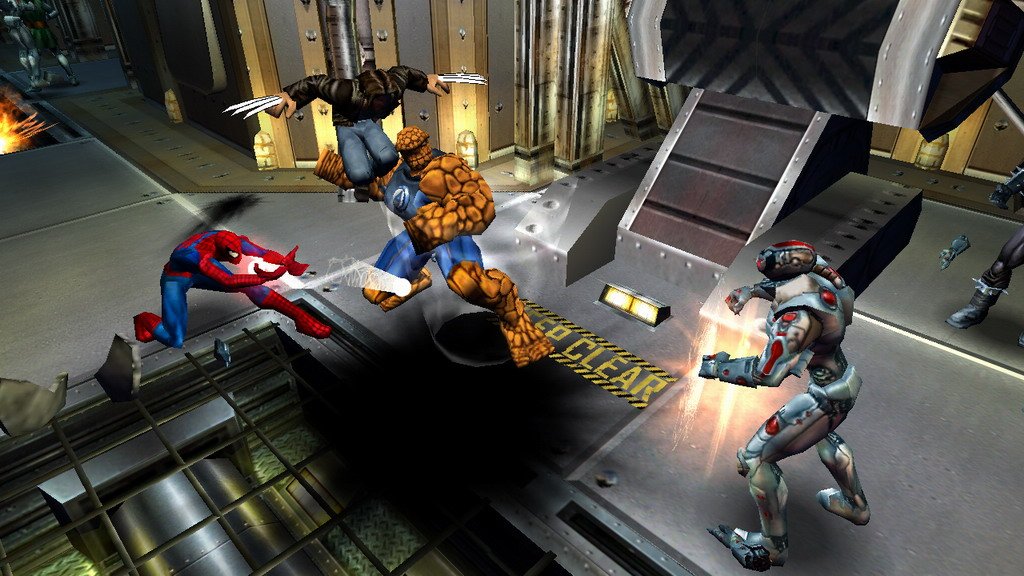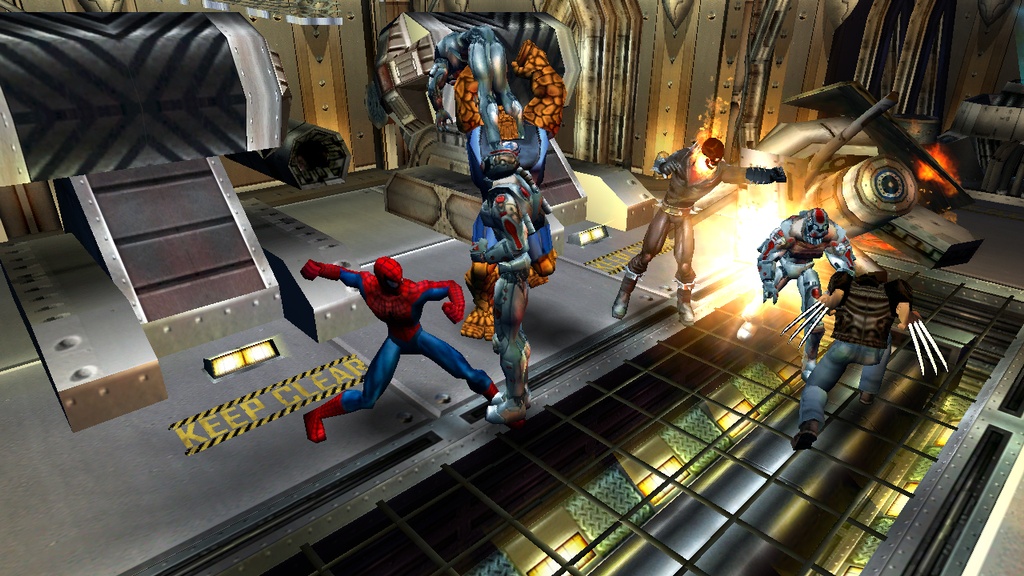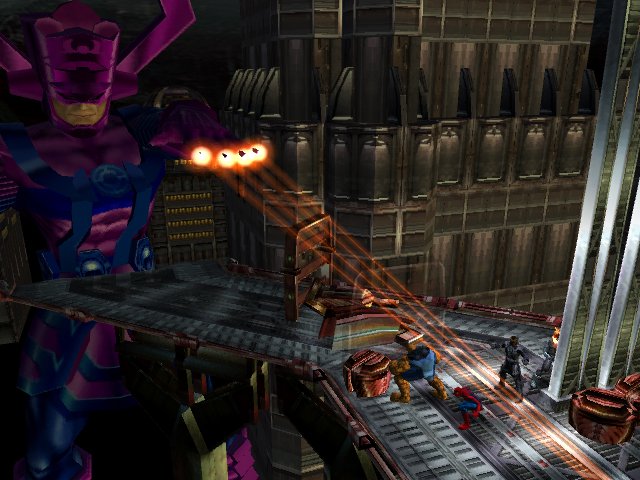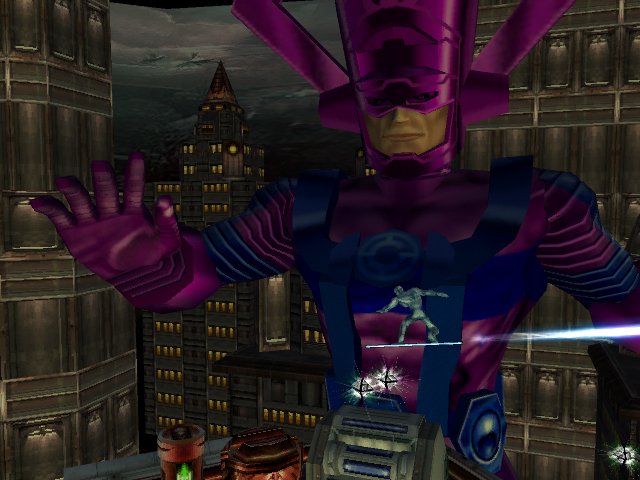In 2004, Raven Software surprised a lot of people with X-Men Legends, an action role-playing game focusing on the exploits of Marvel's mutant superheroes. The Diablo-style gameplay was a significant departure for Raven, a developer best known for its extensive work on first-person shooters. Perhaps more surprising was the game's success in introducing action RPG conventions to the world of superheroes, a fairly novel combination at the time. It proved to be a winning formula, one that Raven further refined with last year's X-Men Legends II: Rise of Apocalypse. Not content with the localized struggles of the X-Men, the concept has been blown out to an intergalactic, interdimensional scale with Marvel: Ultimate Alliance. With more than 20 unique playable heroes; a massive campaign that features a wide variety of well-known Marvel Universe villains, supporting characters, and locations; and plenty of hidden extras, it's the biggest piece of Marvel fan service seen in a video game. It also builds upon a lot of the gameplay systems established in the X-Men Legends games, making for an experience that's deeper, longer lasting, and generally more satisfying.

Ominous deeds are afoot right from the start in Marvel: Ultimate Alliance. Dr. Doom has brought together a coalition of supervillains under the Masters of Evil name, whose first act is to attack a S.H.I.E.L.D. helicarrier. An opposing coalition of superheroes quickly comes to the aid of S.H.I.E.L.D. director Nick Fury, who takes command of the situation and coordinates the superheroes as they continue to track Doom and his minions across the universe and into different dimensions. The sheer quantity of Marvel supervillains you'll face on your quest to defeat Dr. Doom is genuinely staggering. Heavy hitters like Ultron, the Mandarin, Mephisto, Loki, and Galactus all play major roles, but there's still room for lower-profile villains like M.O.D.O.K., Fin Fang Foom, Arcade, Grey Gargoyle, Blackheart, Super Skrull, and literally dozens of others. There are a couple of truly excellent twists and turns, and the story does a good job of concealing the true nature of Dr. Doom's plans until just the right moment. Some of the finer points, such as the excess of long-winded expository speeches in between levels, don't stand up to close scrutiny so well, but the narrative is successful in keeping the game moving at a fast clip.
Your starting lineup in Marvel: Ultimate Alliance consists of Captain America, Thor, Spider-Man, and Wolverine, but after a few levels playing with these heroes, you're given the option to create your own custom team. At first you'll have about 18 different heroes to choose from, and they represent a good cross-section of high-profile heroes and more obscure fan favorites. Old-schoolers like the Fantastic Four, Iron Man, and several X-Men are there, as are a number of heroes who are likely unknown to those who don't keep up with comics, such as Moon Knight, Luke Cage, Spider-Woman, and Deadpool. As you progress you'll run into other heroes such as Blade, Dr. Strange, Ghost Rider, and the Silver Surfer, who will in turn join the cause. Part of the fun of Marvel: Ultimate Alliance is the sheer variety of places the game takes you. While the X-Men Legends games seemed stuck mostly in dungeonlike corridors and sewers and such, here you'll visit some of the most spectacular and mythical locations in the Marvel Universe, including Mephisto's Realm, Asgard, Mandarin's palace, the Skrull homeworld, and, finally, Dr. Doom's sinister Latverian castle. Many of the environments really do look as if they came straight out of a comic book.

The basics of the gameplay should be perfectly familiar by now to fans of hack-and-slash dungeon crawlers like Diablo, Baldur's Gate: Dark Alliance, or Raven's own X-Men Legends games. Commanding a group of four superheroes, you'll fight your way through swarms of enemies, becoming more powerful and gaining new abilities and the occasional piece of gear along the way. From the get-go, everyone can perform a handful of straight-up melee combos. There are a few details that give the basic combat some depth beyond simple button mashing, such as the ability to disarm enemies and grapple with them and enemies that are only susceptible to specific attacks. Each hero has a unique set of special powers, and these special powers, along with, for example, the ability of flight when appropriate, play a big part in giving each hero a unique feel. As different as the abilities can look and feel, most can be easily slotted into a handful of categories. There are melee attacks, radial attacks, projectile attacks, beam attacks, individual and team boosts, and high-powered "xtreme" attacks that you can only trigger after your usually slow-filling momentum meter reaches capacity. Save for the Silver Surfer, who seems stymied by the terranean nature of the gameplay, the heroes feel quite comparable to their ink-and-paper counterparts.
Though you have little control over how your heroes' basic stats (like health and energy) increase, with each new level you're given skill points that you can put toward special powers. Each hero has eight or more special powers in an arsenal, though many of them are inaccessible until you reach certain experience plateaus. You can also use cold, hard cash that you pick up by beating enemies and smashing crates to purchase points, though they start off pricey and become exponentially more so as you progress. Each hero also has three alternate costumes that you can unlock, which not only can drastically affect the hero's appearance, but also come with a unique set of bonuses that you can pay to increase. Defeating significant villains and finding special treasure chests will usually net you a piece of performance-enhancing equipment. Usually any hero can use any gear you happen upon, though it never shows up on their person, and there are also lots of rare pieces of gear that only specific heroes can use.
It would seem that there would be a bit of a conundrum in having an RPG-style experience system with such a huge cast of characters. You'd think that any hero who isn't constantly a part of your active team would become useless after the first level. Marvel: Ultimate Alliance addresses this smartly by artificially increasing the experience levels of nonactive heroes as your active team progresses. Nonactive heroes will usually be about one full experience level behind your active heroes, which is just enough that, should you choose to swap in a hero that you haven't used before, they'll still be tough enough to keep up. Perhaps most interesting about the whole hero customization system in Marvel: Ultimate Alliance is the fact that few of your choices are permanent. Though you can't take back any money spent, any skill points you've earned or purchased can be redistributed to different special powers at the drop of a hat. Additionally, if all of this talk of skill points and team boosts seems boring or confusing to you and you're just interested in beating up lots of bad guys, you'll love that the game handles all character customization by default.

Beyond the individual heroes, the actual team building plays an interesting role in Marvel: Ultimate Alliance. When you're initially given the choice to create a team, you can either pick a prefab group such as the Fantastic Four or the Avengers, or you can pick four heroes of your liking to create a custom team. You can swap in other heroes as you please, but by playing with heroes that have been designated as a part of your team, your team gains reputation points that can be used to infer specific bonuses on the team. Playing with heroes who aren't designated as part of your team will reduce reputation, though if you stick with your initial team of four for a while, you'll be able to add additional heroes to the team. Separate from the team reputation system, who you choose for your team can earn you yet another stat bonus. Some of them are obvious. For example, you'll get an X-Men boost for playing with mutants, and a Fantastic Four bonus for playing with Mister Fantastic, Invisible Woman, Human Torch, and The Thing. Alternately, if you play with, say, Captain America, Spider-Woman, Luke Cage, and Spider-Man, you'll get a New Avengers bonus, while playing with all female characters will earn you a Femme Fatale bonus. Juggling specific heroes' skill points, gear, and costumes, as well as your team reputation points and roster-specific team bonuses, can be overwhelming at times, but this also facilitates a great amount of flexibility for those who seek it.
The amount of crate and barrel smashing that you'll do in Marvel: Ultimate Alliance is discouraging, but the game does a lot to keep the action interesting and varied. There are a few puzzles that you'll have to solve while simultaneously wailing on villains, though they have a tendency to alternate between painfully obvious and excessively obscured. There's no shortage of boss battles, the best of which incorporate Resident Evil 4-style real-time cutscenes that prompt you to press specific face buttons to successfully attack the enemy. The mechanics of these sequences are rarely difficult to pull off, but they make moments like your confrontation with Galactus satisfying and memorable. The game is also unafraid to indulge in the occasional gameplay tangent, which is no more apparent than when you face the villain Arcade in his ominously named amusement park Murderworld. Here, your heroes engage in video game and carnival activities in rather unexpected ways.
You can play Marvel: Ultimate Alliance by yourself, allowing the computer to pick up the slack with the three heroes you're currently not controlling. You can instantly assume control of a different team member, and you have access to some basic team behavior controls as well. The artificial intelligence can generally hold its own, but it doesn't always listen to orders and can act a bit buggy at times. For a better experience, you can have other, real-life players take control at any point for some satisfying cooperative play, which holds true regardless of whether the other players are playing on the same system or over the Internet.
Another fun distraction is the way you can earn experience points in between missions by correctly answering Marvel-themed trivia questions. The trivia questions range from relative basics, like which newspaper Peter Parker works for, to obscure details, like the name of Fin Fang Foom's home planet. There's no time limit for answering questions, making it easy enough to hit up the Internet for answers, and you'll find that you can find the answers to most questions by chatting up non-player characters in the game. Still, it's a nice touch for fans to see just how much they really know about comics.

Even if you choose to ignore the numerous side missions that you'll be presented with along the way, it'll easily take you a good 15 or 20 hours to play through Marvel: Ultimate Alliance, and it's a good ride from start to finish. The game gives you the sense that you can affect how the story ends by certain decisions you make, but these choices are usually pretty superficial and not really worth playing through the entire game again for. The unlockable hard mode is much more attractive since you can import the buffed-up team you already beat the game with.
There are four major platforms to play Marvel: Ultimate Alliance on, and the Xbox 360 is the easy favorite. It features a lot of great lighting, particle, and bump-mapping effects absent from the other versions. Even without those advanced graphical effects, the PC and Xbox versions still look pretty sharp. The PS2 version, however, suffers from an unflattering frame rate, choppy animation, and some oddly muffled sound. That last point is a particular shame, because Marvel: Ultimate Alliance generally sounds pretty good. Some of the voice work is a little corny, but the action packs a punch, and the surprisingly eclectic soundtrack is fantastic, capably shifting gears to keep up with the game's near-constant and dramatic scenery changes.
Beyond being a well-made and accessible action RPG, Marvel: Ultimate Alliance captures the essence of the Marvel Universe, an incredible feat considering the breadth of the source material, though there are just enough omissions to easily justify a sequel. This is simply a must-have for Marvel fans, though the action itself remains satisfying enough for those in search of a good dungeon crawler to enjoy.